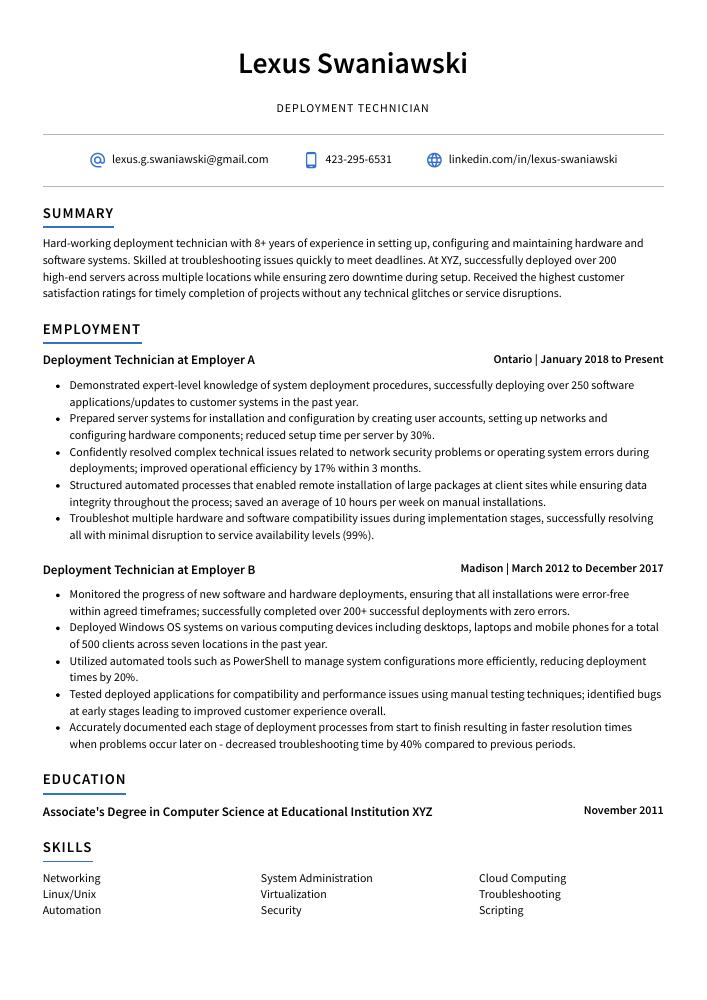Deployment Technician Resume Guide
Deployment Technicians are responsible for installing, configuring, and maintaining computer systems in a networked environment. They set up hardware components such as servers, routers, switches and firewalls to ensure that the system runs smoothly and securely. Additionally they install software applications on computers or mobile devices so users can access them remotely.
Deployment technicians like you are in high demand, yet employers don’t know your name. To get their attention and prove that you’re the best person for the job, a great resume is essential.
This guide will walk you through the entire process of creating a top-notch resume. We first show you a complete example and then break down what each resume section should look like.
Table of Contents
The guide is divided into sections for your convenience. You can read it from beginning to end or use the table of contents below to jump to a specific part.
Deployment Technician Resume Sample
Lexus Swaniawski
Deployment Technician
[email protected]
423-295-6531
linkedin.com/in/lexus-swaniawski
Summary
Hard-working deployment technician with 8+ years of experience in setting up, configuring and maintaining hardware and software systems. Skilled at troubleshooting issues quickly to meet deadlines. At XYZ, successfully deployed over 200 high-end servers across multiple locations while ensuring zero downtime during setup. Received the highest customer satisfaction ratings for timely completion of projects without any technical glitches or service disruptions.
Experience
Deployment Technician, Employer A
Ontario, Jan 2018 – Present
- Demonstrated expert-level knowledge of system deployment procedures, successfully deploying over 250 software applications/updates to customer systems in the past year.
- Prepared server systems for installation and configuration by creating user accounts, setting up networks and configuring hardware components; reduced setup time per server by 30%.
- Confidently resolved complex technical issues related to network security problems or operating system errors during deployments; improved operational efficiency by 17% within 3 months.
- Structured automated processes that enabled remote installation of large packages at client sites while ensuring data integrity throughout the process; saved an average of 10 hours per week on manual installations.
- Troubleshot multiple hardware and software compatibility issues during implementation stages, successfully resolving all with minimal disruption to service availability levels (99%).
Deployment Technician, Employer B
Madison, Mar 2012 – Dec 2017
- Monitored the progress of new software and hardware deployments, ensuring that all installations were error-free within agreed timeframes; successfully completed over 200+ successful deployments with zero errors.
- Deployed Windows OS systems on various computing devices including desktops, laptops and mobile phones for a total of 500 clients across seven locations in the past year.
- Utilized automated tools such as PowerShell to manage system configurations more efficiently, reducing deployment times by 20%.
- Tested deployed applications for compatibility and performance issues using manual testing techniques; identified bugs at early stages leading to improved customer experience overall.
- Accurately documented each stage of deployment processes from start to finish resulting in faster resolution times when problems occur later on – decreased troubleshooting time by 40% compared to previous periods.
Skills
- Networking
- System Administration
- Cloud Computing
- Linux/Unix
- Virtualization
- Troubleshooting
- Automation
- Security
- Scripting
Education
Associate’s Degree in Computer Science
Educational Institution XYZ
Nov 2011
Certifications
Microsoft Certified: Azure DevOps Engineer Expert
Microsoft
May 2017
1. Summary / Objective
The summary or objective at the beginning of your deployment technician resume should be a snapshot of who you are and what makes you an ideal candidate. This is where you can highlight your technical skills, such as experience with various operating systems, knowledge in network infrastructure design, and success deploying large-scale projects. Additionally, mention any certifications or awards that demonstrate your expertise in this field.
Below are some resume summary examples:
Well-rounded deployment technician with 5+ years of experience in hardware and software installations for a wide range of clients. Seeking to join ABC IT Company to utilize technical expertise and customer service skills to troubleshoot support tickets, deploy new systems, perform maintenance tasks, and ensure smooth operations across the organization. Proven record of successfully deploying over 2200 workstations on schedule with zero errors.
Detail-oriented deployment technician with 5+ years of experience supporting IT infrastructure in multiple industries. Experienced in deploying and configuring workstations, laptops, printers, and local area networks. At XYZ Company successfully deployed over 200 new computers for a major client within the set deadline with zero downtime or customer complaints. Received numerous recognition awards from clients for exemplary service delivery.
Energetic deployment technician with 5+ years of experience deploying and maintaining IT hardware, software, and networks. Highly skilled in troubleshooting configuration issues for both Windows and Mac operating systems. At XYZ Company successfully deployed over 1000 laptops to remote locations on time without any major technical hiccups. Recognized for efficiently resolving customer complaints within 24 hours or less.
Diligent and detail-oriented deployment technician with 5+ years of experience in the field. Expertise in physical and remote installation, configuration, troubleshooting, and maintenance of hardware devices. At XYZ Inc., managed large-scale deployments for 200+ locations across multiple states with minimal downtime. Regularly consulted on technical issues to ensure customer satisfaction at all times.
Seasoned deployment technician with 8+ years of experience in the installation and maintenance of IT hardware, software, and networks. Proven success in troubleshooting complex issues across multiple platforms with a focus on customer service that has resulted in high customer satisfaction ratings. Looking to bring my expertise to ABC Tech as a deployment technician for their growing client base.
Skilled deployment technician with 5+ years of experience in planning, installing, and maintaining complex computer systems. Proven ability to troubleshoot system issues quickly and accurately while providing excellent customer service. Seeking to join ABC Tech as a deployment specialist where I can leverage my technical knowledge to ensure quality installations for the company’s clients.
Reliable deployment technician with 5+ years of experience in the IT industry. Experienced in providing on-site support, deploying and configuring hardware/software systems, troubleshooting technical issues and maintaining computer networks. Proven track record of successful deployments for multiple clients across various industries including retail, healthcare, manufacturing and finance.
Driven deployment technician with 5+ years of experience deploying, configuring, and testing hardware and software solutions. Proven track record in reducing deployment time by up to 20% through automation techniques. Seeking to join ABC Tech as a Deployment Technician where I can leverage my technical skillset to support their diverse portfolio of clientele.
2. Experience / Employment
The work history/experience section is where you provide details on your employment history. This should be written in reverse chronological order, meaning the most recent job is listed first.
Stick to bullet points when providing information; this makes it easier for the reader to digest what you have said quickly and effectively. When writing each point, make sure that you include detail about what tasks were completed and any quantifiable results achieved from those actions.
For example, instead of saying “Set up new systems,” you could say, “Successfully installed over 100 computer systems per month with no errors or downtime.”
To write effective bullet points, begin with a strong verb or adverb. Industry specific verbs to use are:
- Installed
- Configured
- Monitored
- Troubleshot
- Optimized
- Upgraded
- Implemented
- Documented
- Analyzed
- Resolved
- Tested
- Managed
- Automated
- Deployed
Other general verbs you can use are:
- Achieved
- Advised
- Assessed
- Compiled
- Coordinated
- Demonstrated
- Developed
- Expedited
- Facilitated
- Formulated
- Improved
- Introduced
- Mentored
- Participated
- Prepared
- Presented
- Reduced
- Reorganized
- Represented
- Revised
- Spearheaded
- Streamlined
- Structured
- Utilized
Below are some example bullet points:
- Revised and tested existing deployment plans for over 200+ applications, ensuring the successful and timely release of updates with zero downtime.
- Spearheaded a new system-wide software deployment strategy to reduce manual labor and optimize resource utilization; achieved 80% reduction in operational costs within 6 months of implementation.
- Assessed potential risks associated with deploying different types of applications based on their size, complexity & compatibility requirements; minimized critical errors by 40%.
- Formulated detailed documentation outlining pre-deployment procedures such as validating user input data & verifying application versions prior to installation/upgrade processes.
- Proficiently managed patch deployments across multiple server environments while adhering to all security protocols established by the organization’s network administrators; decreased vulnerability exposure time from 72 hours down to 24 hours or less on average per month.
- Documented and tracked over 300 deployments of hardware, software and network configurations in the last 6 months; reduced deployment time by 25%.
- Reorganized IT infrastructure design to improve system stability, which resulted in a 50% reduction of downtime for all client systems.
- Consistently maintained high performance levels across 200+ servers with daily updates and patches; decreased incidents related to server outages or slowdowns by 65%.
- Resolved technical issues faced during deployment process within an average 30 minutes per incident, thereby improving customer satisfaction ratings by 20%.
- Advised engineering teams on best practices for deploying new technologies such as cloud computing solutions & virtualization platforms; achieved company-wide cost savings of up to $10K per month due to optimization efforts.
- Developed and implemented deployment plans for over 100 software releases, increasing the success rate of deployments by 25%.
- Mentored and provided technical support to junior technicians on a variety of complex network issues; reduced downtime from 2 hours per incident to 30 minutes or less.
- Reliably configured new hardware devices and established secure connections with existing networks in accordance with corporate policies; improved system security by 90% within 3 months.
- Introduced innovative automation processes that increased efficiency up to 40%, enhancing productivity throughout the organization’s IT infrastructure team as well as other departments company-wide.
- Compiled detailed reports outlining all updates, installations, repairs, patches and configurations made during each deployment cycle; enabled easy analysis of data for future decision-making purposes.
- Managed the deployment of over 500 new computer systems to various locations across the country, ensuring all components were properly configured and ready for use within 3 days.
- Expedited the installation process by setting up an average of 30 computers a day, reducing IT-related downtime by 40%.
- Presented technical information in easy-to-understand terms to customers during training sessions on new system features; increased customer satisfaction ratings from 75% to 92%.
- Reduced user onboarding time significantly by automating basic processes such as software installation and configuration using scripting tools like Bash & PowerShell scripts.
- Actively tracked hardware failures and maintenance requests through ticketing systems, resolving issues with minimal disruption within 2 hours on average per case.
- Optimized software deployment procedures to deploy over 500 software packages daily, resulting in a 15% increase in productivity.
- Participated actively in the configuration of virtual machines and their associated networks; set up 200+ servers within 6 weeks at minimum cost.
- Represented the company onsite during technical operations such as installation and maintenance of hardware & software components; successfully met customer requirements & expectations with 100% satisfaction rate.
- Substantially reduced downtime by troubleshooting issues related to system availability, reliability and performance using advanced debugging techniques; decreased it from 10 hours per week to 2 hours per week on average.
- Upgraded existing systems utilizing both manual methods and automated tools for better scalability and efficiency with no disruption or loss of data integrity/availability throughout all deployments.
- Analyzed and documented existing network infrastructure to identify areas of improvement, resulting in a 15% decrease in deployment time.
- Coordinated with multiple teams to deploy software upgrades and patching systems on over 500 computers each month, ensuring that all equipment met the latest security standards.
- Independently set up desktop configurations for new employees across different departments; completed setup within 2 hours per computer on average and reduced manual labor by 30%.
- Achieved 98% success rate when deploying complex applications onto Windows/Mac OSX operating systems using Microsoft Deployment Toolkit (MDT) & System Centre Configuration Manager (SCCM).
- Streamlined system maintenance processes through automation scripts which improved hardware reliability by 25%, reducing the number of service tickets due to malfunctioned devices by 60%.
- Automated the deployment process of over 100 applications per month, reducing the implementation time by 15%.
- Implemented and configured a new release-tracking system to improve software deployments; achieved milestone goals 2 weeks ahead of schedule and reduced errors by 27%.
- Configured custom application environments for clients based on their specific requirements, ensuring that all deployed systems met industry standards.
- Improved customer satisfaction levels with timely installation & maintenance services, successfully meeting 99%+ client service level agreements (SLAs).
- Meticulously tested each application prior to deployment using an array of tools such as UAT scripts and regression testing strategies; identified & resolved any issues within 24 hours on average.
3. Skills
Skill requirements will differ from one employer to the next; this can easily be ascertained from the job posting. Organization A may require the candidate to be knowledgeable in Linux, while Organization B may require experience with Windows.
It is essential to tailor your skills section of the resume for each job you are applying for because many employers use applicant tracking systems these days that scan resumes for certain keywords before passing them on to a human.
Once listed here, it can be beneficial to further elaborate on your qualifications by discussing them in more detail within other areas such as the summary or experience sections.
Below is a list of common skills & terms:
- Automation
- Cloud Computing
- Linux/Unix
- Network Monitoring
- Networking
- Scripting
- Security
- System Administration
- Troubleshooting
- Virtualization
4. Education
Including an education section on your resume will depend largely upon how far along you are in your career. If you just graduated and have no work experience, it is important to mention your educational background below the objective statement. However, if you already have extensive deployment technician experience under your belt, an education section may not be necessary.
If including an education section is appropriate for the role and company culture, try to include any courses or assignments related to the position of a deployment technician that demonstrate technical skills relevant to this job.
Associate’s Degree in Computer Science
Educational Institution XYZ
Nov 2011
5. Certifications
Certifications are a great way to demonstrate your expertise in a certain field. They show potential employers that you have taken the time and effort to learn more about the industry, as well as prove that you can handle tasks related to it.
Including certifications on your resume is an effective way of showing hiring managers that you are qualified for the job and will be able to hit the ground running if hired. Make sure any relevant certifications are listed prominently so they don’t get overlooked by recruiters!
Microsoft Certified: Azure DevOps Engineer Expert
Microsoft
May 2017
6. Contact Info
Your name should be the first thing a reader sees when viewing your resume, so ensure its positioning is prominent. Your phone number should be written in the most commonly used format in your country/city/state, and your email address should be professional.
You can also choose to include a link to your LinkedIn profile, personal website, or other online platforms relevant to your industry.
Finally, name your resume file appropriately to help hiring managers; for Lexus Swaniawski, this would be Lexus-Swaniawski-resume.pdf or Lexus-Swaniawski-resume.docx.
7. Cover Letter
Writing a cover letter is an important step in the job application process. It should introduce you to a potential employer and provide them with more information about who you are as a professional.
Cover letters typically consist of 2-4 paragraphs, each one highlighting different aspects of your qualifications for the role. Your cover letter should include details that aren’t already mentioned on your resume and demonstrate why you’d be an excellent fit for the position.
Below is an example cover letter:
Dear Kim,
I am writing in response to your posting for a Deployment Technician. With my experience in computer hardware and software installation, troubleshooting, and repair; as well as my strong customer service skills, I feel confident I would be a valuable addition to your team.
In my current role as a Deployment Technician at ABC Company, I am responsible for installing and configuring new computer systems, applications, and networks. I also provide Tier 1 support to employees experiencing technical issues. In addition to my technical expertise, I have excellent interpersonal skills and enjoy helping people solve problems.
Some highlights of my experience include:
– Installing and configuring more than 500 new computer systems over the past year – Troubleshooting hardware and software issues via phone or in person – Coordinating with vendors to resolve technical problems – Providing on-site training to users on how to use new systems or applications
I am knowledgeable of a variety of hardware and software platforms (Windows, MacOS, Linux) and have experience working in both corporate environments as well as small businesses. My ability to quickly learn new technologies combined with my strong customer service skills makes me an ideal candidate for this position. Please find attached a copy of my resume for your review. If you have any questions about my qualifications or experience please do not hesitate to contact me at [phone number] or [email address]. Thank you for your time!
Sincerely,
Lexus
Deployment Technician Resume Templates
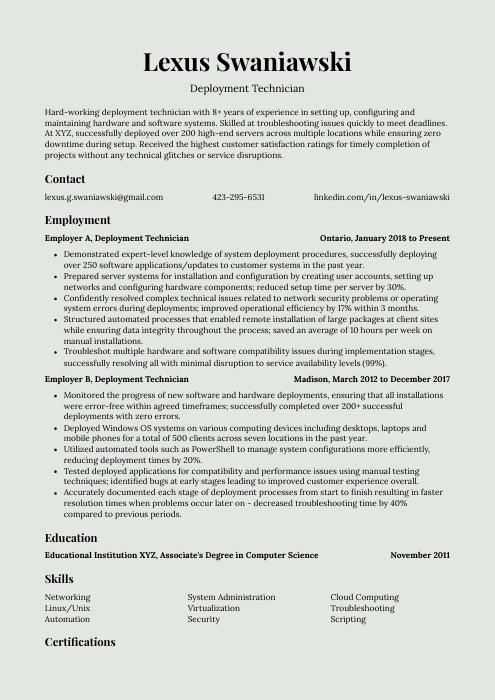 Saola
Saola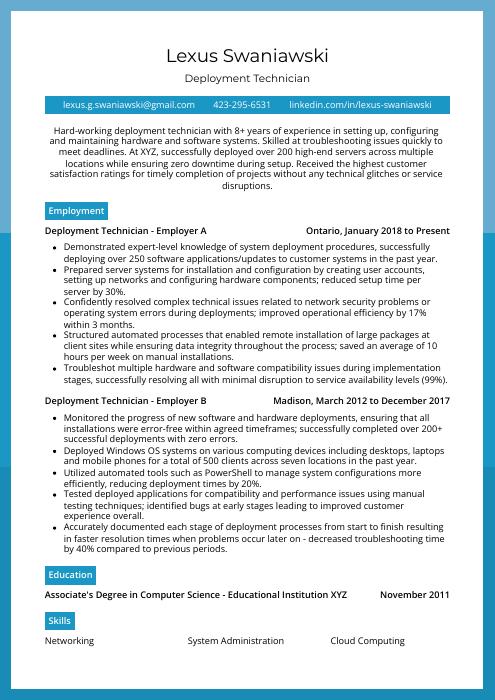 Rhea
Rhea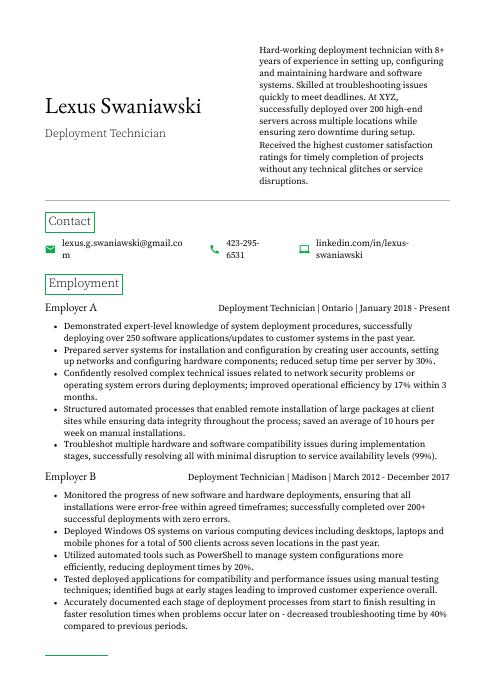 Quokka
Quokka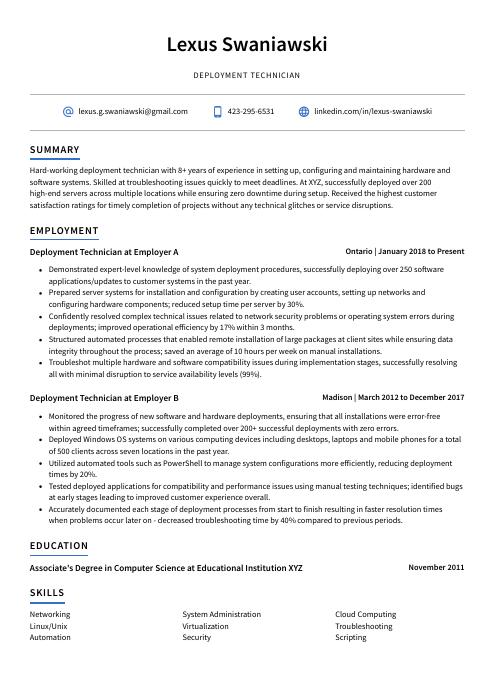 Axolotl
Axolotl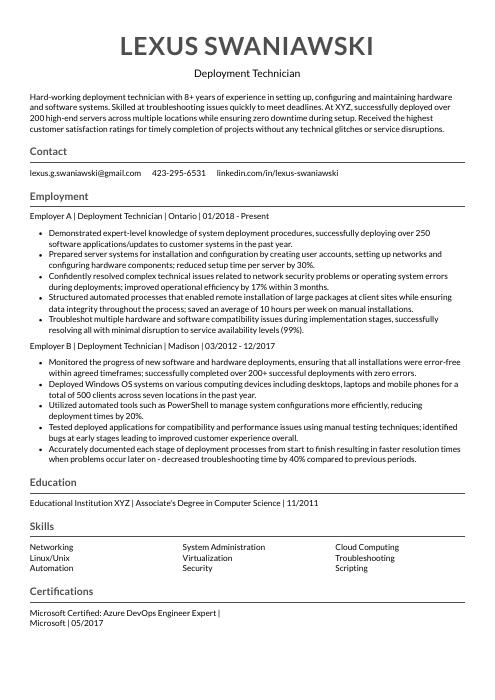 Indri
Indri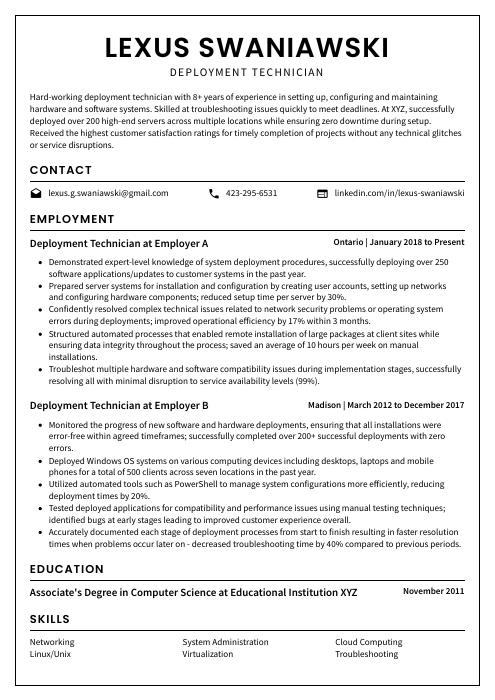 Cormorant
Cormorant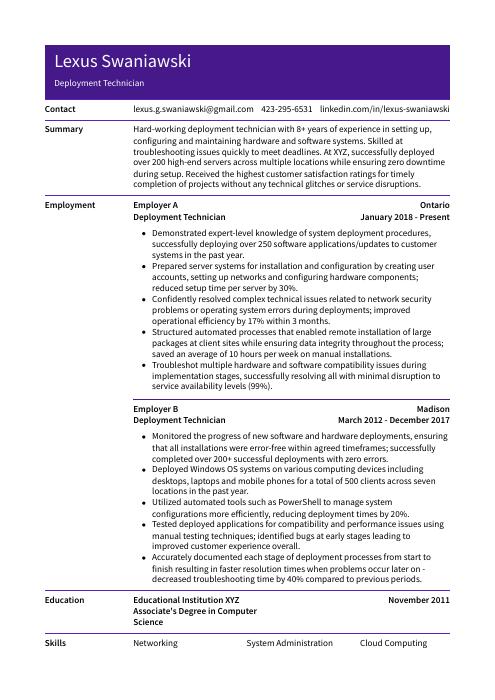 Pika
Pika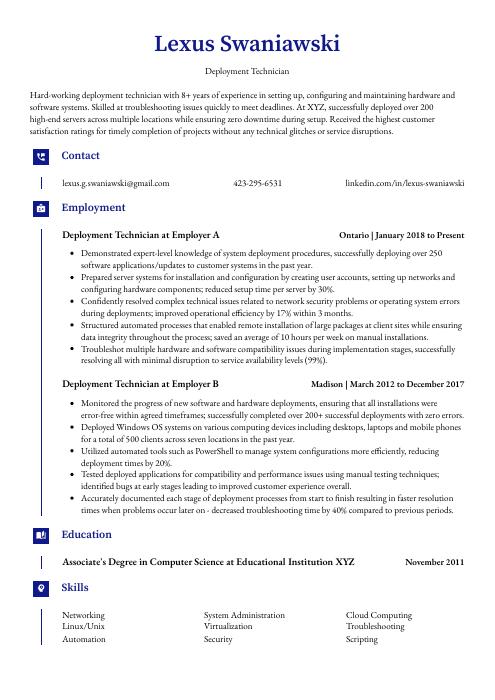 Gharial
Gharial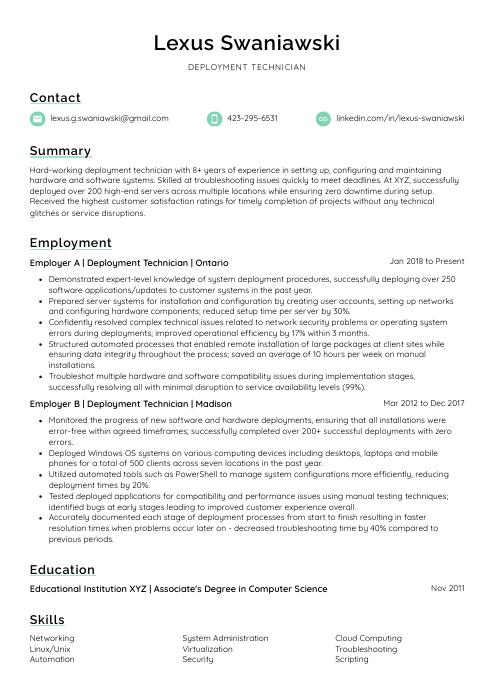 Lorikeet
Lorikeet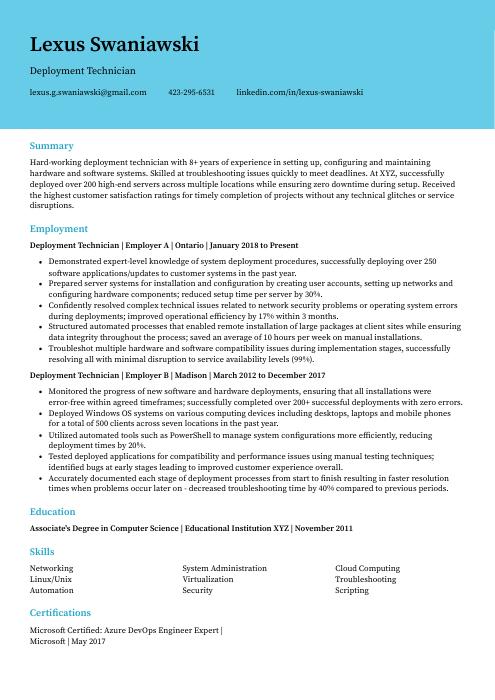 Dugong
Dugong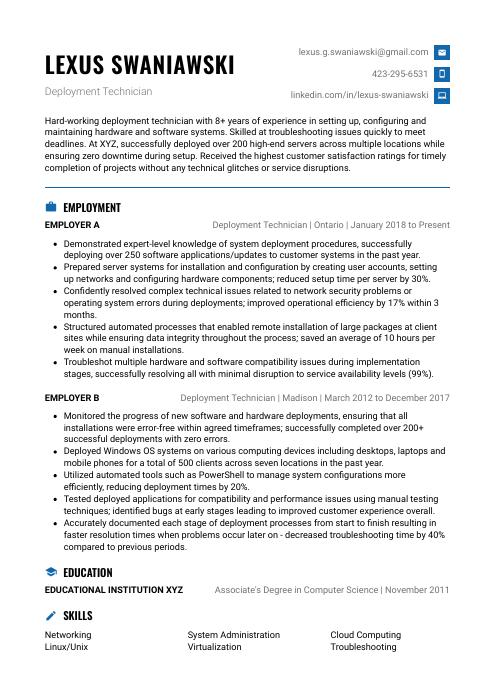 Echidna
Echidna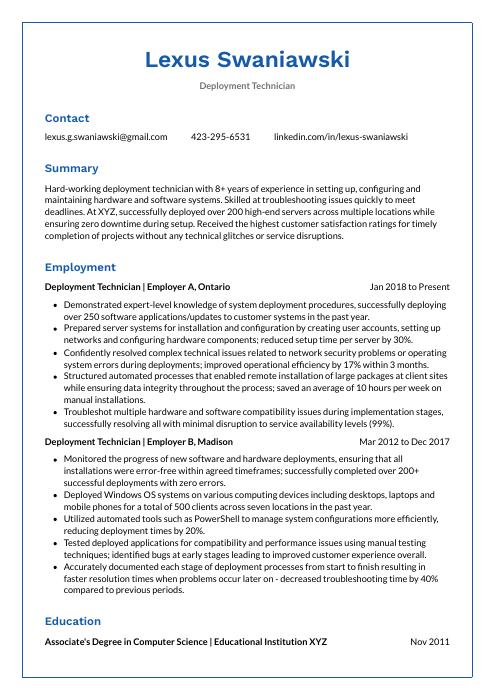 Markhor
Markhor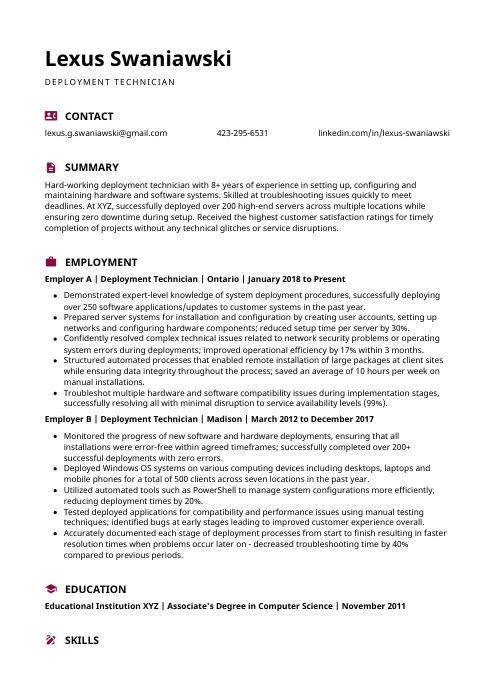 Hoopoe
Hoopoe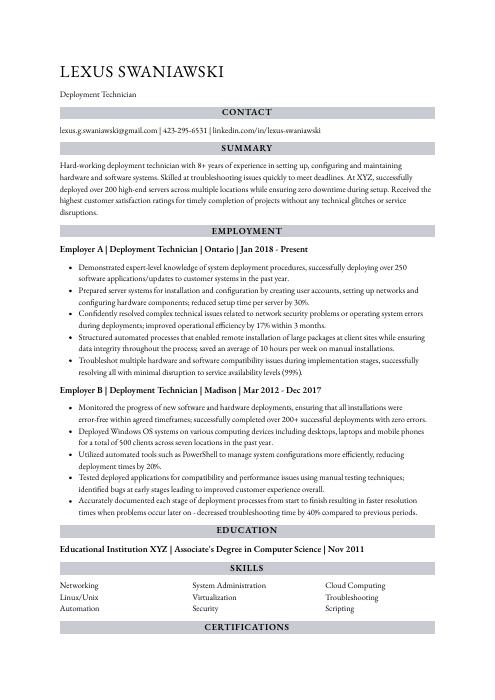 Numbat
Numbat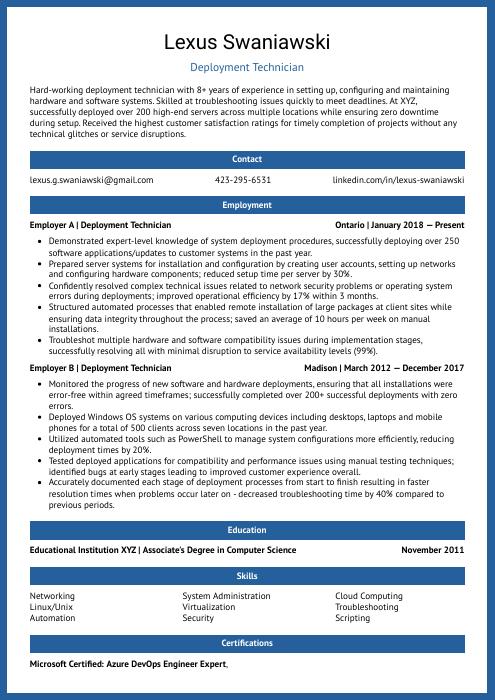 Ocelot
Ocelot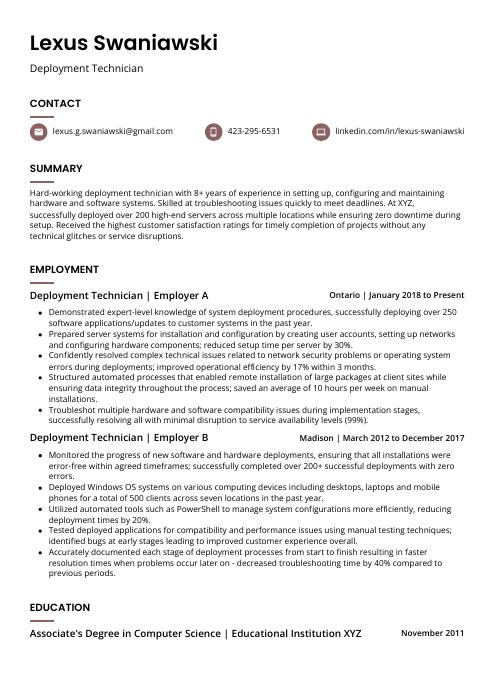 Fossa
Fossa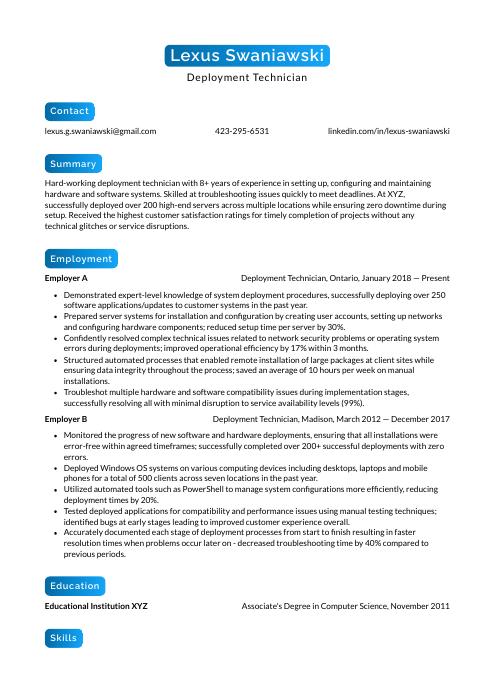 Kinkajou
Kinkajou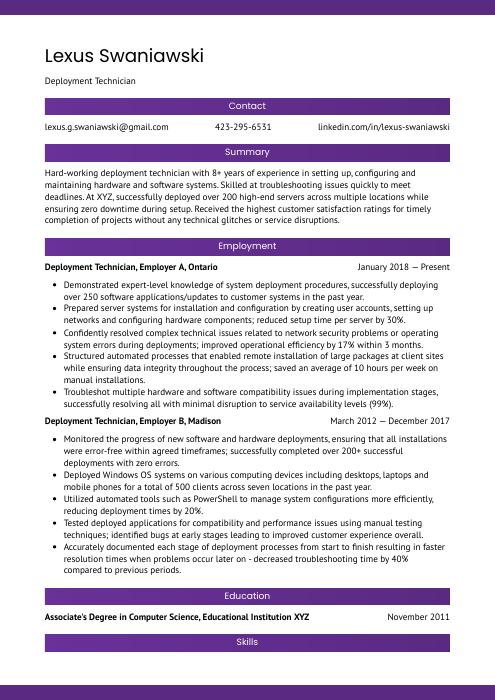 Jerboa
Jerboa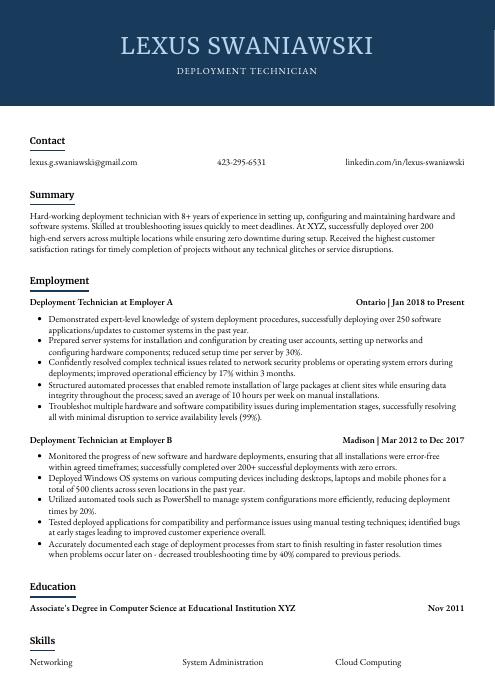 Bonobo
Bonobo Rezjumei
Rezjumei
